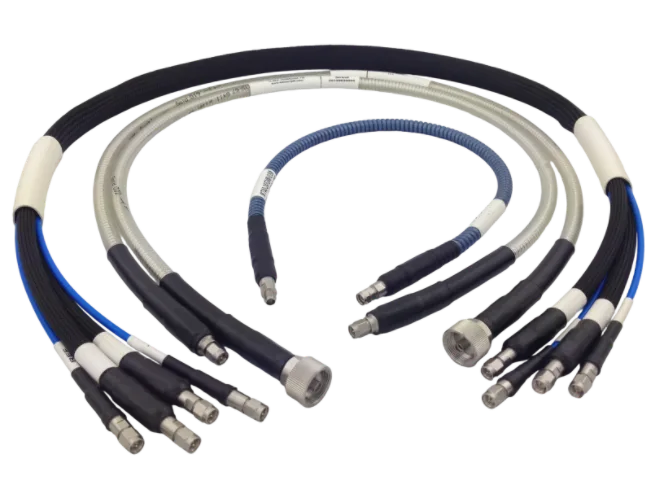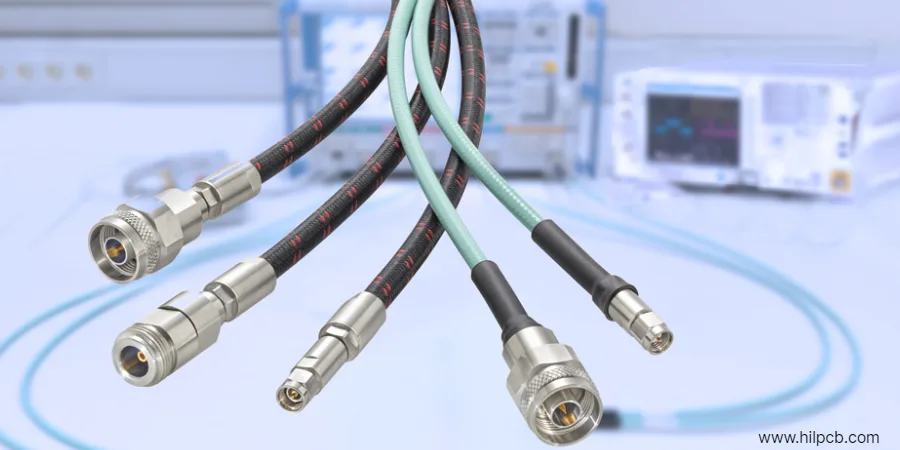What Is a Radio Frequency Cable?
A radio frequency cable (RF cable), often referred to as coaxial cable, is designed to carry high-frequency electrical signals with minimal signal loss and interference. These cables are essential in a wide range of applications, from telecommunications and broadcasting to medical equipment and military systems.
RF cables are constructed to prevent electromagnetic interference (EMI) and to preserve signal integrity over longer distances or at higher frequencies. They are built with an inner conductor, dielectric insulation, metal shielding, and an outer jacket, which all work together to reduce signal degradation and prevent external noise from distorting the signal.
Types of Radio Frequency Cables
There are several types of RF cables, each tailored to specific applications and performance requirements. Below, we explore the most commonly used RF cable types:
Coaxial RF Cables
Coaxial RF cables are the most commonly used cables in high-frequency applications. They consist of a central conductor, dielectric insulation, metal shielding, and an outer protective jacket. These cables are suitable for telecommunications, broadcast, consumer electronics, and more.
Common types of coaxial cables include:
- RG-58: Lightweight and ideal for amateur radio or short-range applications.
- RG-213: Heavier and more durable, used for high-power systems.
- LMR Series: Flexible, low-loss cables typically used in wireless communication systems.
Advantages:
- Excellent shielding against external interference.
- Widely used with easy access to components and connectors.
Considerations:
- Can have higher signal loss at very high frequencies compared to more specialized cables.
Semi-Rigid Coaxial Cables
Semi-rigid RF cables are designed for high-performance systems where low signal loss and improved shielding are critical. Unlike flexible coaxial cables, they feature a solid dielectric that holds the conductor in place, making them ideal for high-precision applications.
Applications:
- Used in microwave communication, aerospace, and high-precision RF testing.
Advantages:
- Excellent signal integrity with minimal attenuation.
- Strong shielding capabilities.
Considerations:
- Not as flexible as standard coaxial cables, requiring special tools for installation.
Twinaxial and Triaxial Cables
Twinaxial and triaxial cables are variations of coaxial cables that offer additional conductors or shielding. They are often used in systems where signal purity and reduced crosstalk are critical.
Applications:
- High-speed networking and data transmission systems requiring high immunity to interference.
Advantages:
- Enhanced shielding and signal transmission security.
- Ideal for data centers, military systems, and environments with high EMI.
Considerations:
- Higher cost due to added shielding layers.
- Less flexible than standard coaxial cables.
Micro-Coaxial Cables
Micro-coaxial cables are small, flexible cables designed for use in tight spaces, typically found in medical devices, wearable electronics, and compact RF systems.
Applications:
- Wearable technology, IoT devices, and medical instrumentation.
Advantages:
- Extremely small and flexible, ideal for compact systems.
- Low signal loss over short distances.
Considerations:
- Limited bandwidth compared to larger cables.
- Not suitable for long-distance transmission.

Custom RF Cables: Solving the Problem of Finding Reliable Manufacturers
Finding a reliable RF cable manufacturer can be a challenge. Custom RF cables are often necessary for projects with specific performance requirements, but sourcing these cables from a trustworthy and efficient manufacturer can be difficult, especially when there are limited options available.
The Challenge
While many manufacturers offer off-the-shelf RF cables, it’s not always easy to find one that provides custom RF cable solutions that meet your unique needs. Whether it’s for specialized shielding, impedance matching, or low-loss transmission for specific frequencies, finding a reliable source that can produce cables with the exact specifications required for your project can be time-consuming.
Many companies offer generic cables that might not meet the exact needs of high-performance systems or specific environmental conditions. This often leaves companies struggling to find a source that can deliver customized cables on time, with the right materials and at a competitive price.
How HILPCB Can Help
At HILPCB, we understand the challenges of finding reliable custom RF cable manufacturers. As a leading PCB manufacturer and electronic assembly provider, we offer comprehensive solutions, including the production of custom RF cables for high-frequency and high-performance applications. Whether you require low-loss cables for telecommunications, high-frequency cables for aerospace systems, or flexible cables for medical devices, we can provide you with cables that meet your specific needs.
By partnering with HILPCB, you get the assurance of a high-quality manufacturing process, fast lead times, and seamless integration with your overall manufacturing process, making it easier for you to focus on your project without the hassle of sourcing cables from multiple suppliers.

Key Factors to Consider When Choosing an RF Cable
Selecting the right RF cable requires consideration of various factors to ensure the best performance for your system:
Frequency Range & Signal Attenuation
Signal attenuation increases with frequency, so it's essential to choose a cable that minimizes signal loss over the intended distance. For long-distance applications or high-frequency systems, low-loss cables are necessary to preserve signal integrity.
Impedance Matching
Impedance matching is crucial to prevent signal reflection and ensure maximum power transfer. Most RF cables come in either 50 Ω (common for communication systems) or 75 Ω (for broadcast and video systems). Matching the impedance of your cable to your system is critical to avoid performance issues.
Shielding Effectiveness
Shielding helps protect the RF signal from electromagnetic interference (EMI). High-quality shielding ensures that your signal is not degraded by external noise, which is especially important in environments with high EMI, such as industrial or military systems.
Flexibility & Durability
The physical characteristics of the cable are important for installation and long-term performance. Flexible RF cables are ideal for dynamic applications, while semi-rigid cables provide stability and precision in static setups.
Applications of RF Cables
RF cables play a crucial role in many industries, including:
- Telecommunications: For connecting base stations, antennas, and microwave links.
- Broadcasting: Transmitting video and audio signals from TV/radio stations to transmitters.
- Aerospace & Defense: Supporting radar systems, satellite communications, and military electronics.
- Medical Equipment: Used in MRI machines, ultrasound, and other diagnostic devices.
- Test & Measurement: Connecting signal analyzers, network test equipment, and oscilloscopes for high-precision testing.
- IoT & Automotive: RF cables are used in wireless sensors, telematics, and vehicle communication systems.
Conclusion
Selecting the right RF cable for your system is critical to maintaining signal integrity and ensuring reliable performance. With various types of cables available, including custom RF cables designed for specific applications, understanding the requirements of your project is key to choosing the most suitable solution. Whether you need off-the-shelf cables or custom designs, HILPCB can provide high-quality RF cables that meet your exact specifications.
For reliable, custom RF cables that align with your system's performance needs, consider HILPCB. With our expertise in PCB manufacturing, electronic assembly, and custom RF cable production, we offer a one-stop solution for all your RF connectivity needs.
FAQ
Q1: What’s the difference between 50 Ω and 75 Ω RF cables?
A1: 50 Ω cables are typically used for RF communications, while 75 Ω cables are more common for video and broadcast applications. Mismatched impedance can lead to signal loss and degradation.
Q2: Can RF cables be used for high-power applications?
A2: Yes, but ensure that you choose cables specifically rated for high-power transmission to avoid signal degradation or overheating.
Q3: How do I reduce signal loss in long RF cable runs?
A3: Use low-loss cables, avoid excessive cable length, and ensure proper connectors and terminations to maintain signal quality.
Q4: When should I use custom RF cables instead of stock cables?
A4: If your system requires specific impedance, shielding, or performance characteristics, custom RF cables offer a tailored solution that ensures optimal operation.
Q5: What environmental factors affect RF cable performance?
A5: Environmental factors like temperature, moisture, vibration, and UV exposure can degrade cable performance. Select cables with appropriate jackets and shielding for your application.
Request Your RF Cable Quote Now
If you’re looking for high-quality RF cables or custom RF cable solutions, HILPCB offers professional manufacturing services to meet your needs. Contact us today for a tailored quote!

